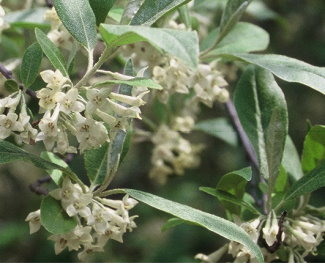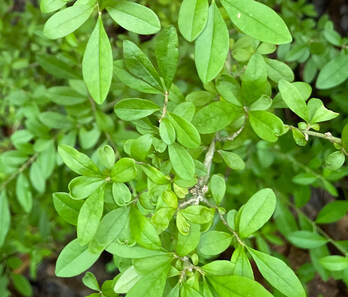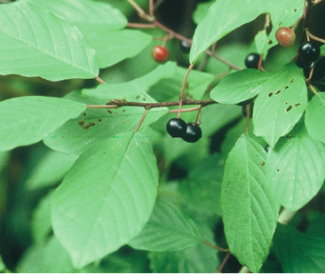ALTERNATIVE LIST OF PLANT TO REPLACE INVASIVES
Key:
US - plant native to US
OH - plant native to Ohio
NN - a non-native species
CV - a cultivated variety (cultivar)
* next to name indicates species is ranked as "Potentially Invasive". All other species have been assessed as "Invasive".
US - plant native to US
OH - plant native to Ohio
NN - a non-native species
CV - a cultivated variety (cultivar)
* next to name indicates species is ranked as "Potentially Invasive". All other species have been assessed as "Invasive".
TREES
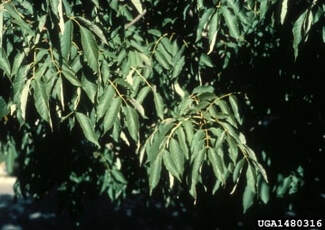
Amur Corktree (Phellodendron amurense)
• Opposite, pinnately compound leaves, with citrus smell
• Thick corky outer bark with bright yellow inner bark
• Separate male & female trees; females have green fruits, turning black in the fall
Recommended Alternatives:
* Black walnut (Juglans nigra)
* Hackberry (Celtis occidentalis)
* Kentucky coffee tree (Gymnocladus dioicus)
* Northern pecan (Carya illinoiensis)-US
• Opposite, pinnately compound leaves, with citrus smell
• Thick corky outer bark with bright yellow inner bark
• Separate male & female trees; females have green fruits, turning black in the fall
Recommended Alternatives:
* Black walnut (Juglans nigra)
* Hackberry (Celtis occidentalis)
* Kentucky coffee tree (Gymnocladus dioicus)
* Northern pecan (Carya illinoiensis)-US

Callery Pear (Pyrus calleryana)
• White flowers in early spring have a bad odor; glossy leaves which turn
red to purple in fall
• Fast growth, often invading roadsides, fields, and meadows
• Cultivars cross-pollinate to produce many, marble-sized inedible fruits
Recommended Alternatives:
* American plum (Prunus americana)
* Basswood (Tilia americana)
* Black tupelo (Nyssa sylvatica)-OH
* Cucumber magnolia (Magnolia acuminata)
* Persimmon (Diospyros virginiana)
* Serviceberry (Amelanchier spp.)-US/OH
* Willow oak (Quercus phellos)-US
• White flowers in early spring have a bad odor; glossy leaves which turn
red to purple in fall
• Fast growth, often invading roadsides, fields, and meadows
• Cultivars cross-pollinate to produce many, marble-sized inedible fruits
Recommended Alternatives:
* American plum (Prunus americana)
* Basswood (Tilia americana)
* Black tupelo (Nyssa sylvatica)-OH
* Cucumber magnolia (Magnolia acuminata)
* Persimmon (Diospyros virginiana)
* Serviceberry (Amelanchier spp.)-US/OH
* Willow oak (Quercus phellos)-US
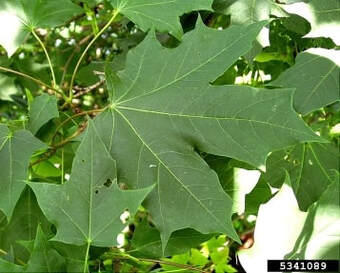
Norway Maple (Acer plantanoides)*
• Leaves similar to sugar maple, but broader than high; blunt leaf buds
• Bark is grayish black and furrowed
• Milky sap
Recommended Alternatives:
* American yellowwood (Cladrastis kentukea)
* Black maple (Acer nigrum)
* Cucumber magnolia (Magnolia acuminata)
* Red maple (Acer rubrum)
* Sugar maple (Acer saccharum)
• Leaves similar to sugar maple, but broader than high; blunt leaf buds
• Bark is grayish black and furrowed
• Milky sap
Recommended Alternatives:
* American yellowwood (Cladrastis kentukea)
* Black maple (Acer nigrum)
* Cucumber magnolia (Magnolia acuminata)
* Red maple (Acer rubrum)
* Sugar maple (Acer saccharum)
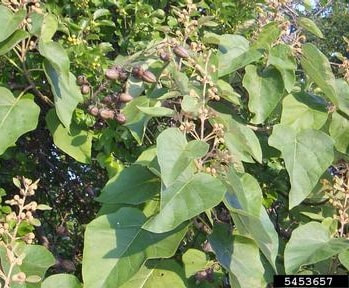
Princess Tree (Paulownia tomentosa)*
• Large, opposite, hairy leaves, broadly oval to heart-shaped
• Showy, pale violet flowers, produced in upright clusters in spring
• Fast-growing and aggressive
Recommended Alternatives:
* Basswood (Tilia americana)
* Cucumber magnolia (Magnolia acuminata)
* Tulip-tree (Lirodendron tulipifera)
• Large, opposite, hairy leaves, broadly oval to heart-shaped
• Showy, pale violet flowers, produced in upright clusters in spring
• Fast-growing and aggressive
Recommended Alternatives:
* Basswood (Tilia americana)
* Cucumber magnolia (Magnolia acuminata)
* Tulip-tree (Lirodendron tulipifera)
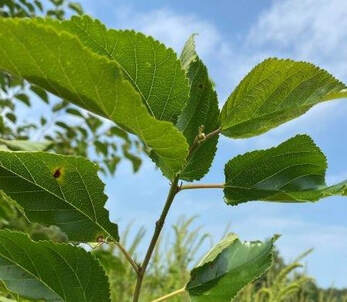
White Mulberry (Morus alba)*
• Alternate, toothed, glossy leaves, unlobed and lobed
• Separate male & female trees; females loaded with multi-seeded berries
• Inner bark is bright orange
Recommended Alternatives:
* American hop hornbeam (Ostrya virginiana)
* Basswood (Tilia americana)
* Persimmon (Diospyros virginiana)
* Red mulberry (Morus rubra)
NOTE: Red mulberry is native, but hard to distinguish from white mulberry. Weeping mulberry ('Chaparral') is in the nursery trade, a CV of white mulberry.
• Alternate, toothed, glossy leaves, unlobed and lobed
• Separate male & female trees; females loaded with multi-seeded berries
• Inner bark is bright orange
Recommended Alternatives:
* American hop hornbeam (Ostrya virginiana)
* Basswood (Tilia americana)
* Persimmon (Diospyros virginiana)
* Red mulberry (Morus rubra)
NOTE: Red mulberry is native, but hard to distinguish from white mulberry. Weeping mulberry ('Chaparral') is in the nursery trade, a CV of white mulberry.
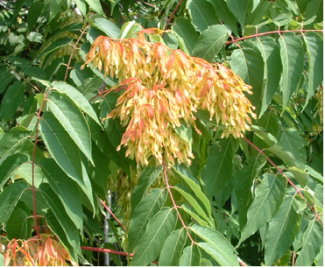
Tree-of-Heaven (Ailanthus altissima)
• Fast-growing, deciduous tree with rank-smelling leaves
• Thrives as an early successional species in woods
• Female trees produce many fruits and it re-sprouts quickly from cut stumps
Recommended Alternatives:
* American hophornbeam (Ostrya virginiana)-OH
* Cucumber magnolia (Magnolia acuminata)-OH
* Pawpaw (Asimina triloba)
* Northern pecan (Carya illinoiensis)-US
* Redbud (Cercis canadensis)
* Staghorn sumac (Rhus typhina)
* Tulip-tree (Liriodendron tulipifera)
* Yellow buckeye (Aesculus lava)
• Fast-growing, deciduous tree with rank-smelling leaves
• Thrives as an early successional species in woods
• Female trees produce many fruits and it re-sprouts quickly from cut stumps
Recommended Alternatives:
* American hophornbeam (Ostrya virginiana)-OH
* Cucumber magnolia (Magnolia acuminata)-OH
* Pawpaw (Asimina triloba)
* Northern pecan (Carya illinoiensis)-US
* Redbud (Cercis canadensis)
* Staghorn sumac (Rhus typhina)
* Tulip-tree (Liriodendron tulipifera)
* Yellow buckeye (Aesculus lava)
SHRUBS
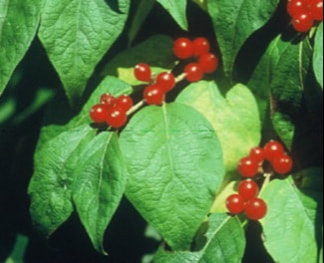
Asian Bush Honeysuckles: Amur, Morrow, and Tatarian (Lonicera maackii, Lonicera morrowii, and Lonicera tatarica)
• Form dense populations in the understory of woods
• Leaf out early and hold leaves late in the fall
• Seeds from red berries are dispersed by birds and deer
Recommended Alternatives:
* American hazelnut (Corylus americana)
* Bottlebrush buckeye (Aesculus parviflora)-US
* Black chokeberry (Aronia melanocarpa)-OH
* Common winterberry (Ilex verticillata)-OH (and CVs)
* Dogwoods (Cornus amomum, C. racemosa)
* Red buckeye (Aesculus pavia)
* Red chokeberry (Aronia arbutifolia 'Brillantissima')-CV
* Summersweet clethra (Clethra alnifolia)-US
• Form dense populations in the understory of woods
• Leaf out early and hold leaves late in the fall
• Seeds from red berries are dispersed by birds and deer
Recommended Alternatives:
* American hazelnut (Corylus americana)
* Bottlebrush buckeye (Aesculus parviflora)-US
* Black chokeberry (Aronia melanocarpa)-OH
* Common winterberry (Ilex verticillata)-OH (and CVs)
* Dogwoods (Cornus amomum, C. racemosa)
* Red buckeye (Aesculus pavia)
* Red chokeberry (Aronia arbutifolia 'Brillantissima')-CV
* Summersweet clethra (Clethra alnifolia)-US
|
Autumn and Russian Olives (Elaeagnus umbellata, Elaeagnus angustifolia)
• Shrub, small tree with silvery leaves, thrives in poor soil • Fruit is red (autumn-olive) or yellow (Russian), containing seeds with high viability • Fragrant cream-colored or pale yellow flowers in spring Recommended Alternatives: * American hazelnut (Corylus americana) * American hophornbeam (Ostrya virginiana)-OH * American smokebush (Cotinus americanus) * Black chokeberry (Aronia melanocarpa) * Bladdernut (Staphylea trifolia) * Common witch-hazel (Hamamelis virginiana) * Elderberry (Sambucus canadensis)-several CVs * Native dogwoods (Cornus amomum, Cornus racemosa)-OH * Serviceberry (Amelachier spp.) |
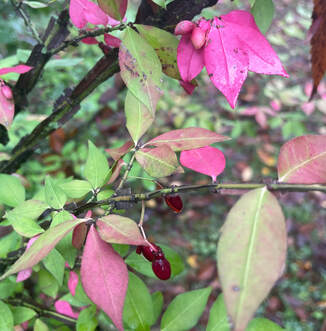
Burning Bush (Euonymus alatus)
• Multi-stemmed, branching shrub with conspicuous winged stems, 5-10’ tall
• Opposite, toothed leaves, turning red-purple in the fall
• Flowers are greenish and inconspicuous; fruits are small and red
Recommended Alternatives:
* American hazelnut (Corylus americana)
* Common witch-hazel (Hamamelis virginiana)
* Dwarf fothergilla (Fothergilla gardenii)-US
* Eastern wahoo (Euonymus atropurpureus)
* Red twig dogwood cultivars (Cornus alba)
* Spicebush (Lindera benzoin)
* Strawberry bush (Euonymus americanus)
* Winterberry (Ilex verticillata)
• Multi-stemmed, branching shrub with conspicuous winged stems, 5-10’ tall
• Opposite, toothed leaves, turning red-purple in the fall
• Flowers are greenish and inconspicuous; fruits are small and red
Recommended Alternatives:
* American hazelnut (Corylus americana)
* Common witch-hazel (Hamamelis virginiana)
* Dwarf fothergilla (Fothergilla gardenii)-US
* Eastern wahoo (Euonymus atropurpureus)
* Red twig dogwood cultivars (Cornus alba)
* Spicebush (Lindera benzoin)
* Strawberry bush (Euonymus americanus)
* Winterberry (Ilex verticillata)
|
Common Privet (Ligustrum vulgare)*
• Small, lanceolate leaves; flowers are white to cream in terminal panicles • Fruits are small, green turning to dark purple or black • Shrub to small tree, often with many stems and thorny projections Recommended Alternatives: * Black chokeberry (Aronia melanocarpa) * Common witch-hazel (Hamamelis virginiana) * Dwarf diervilla (Diervilla lonicera) * Ninebark (Physocarpus opulifolius) * Red chokeberry (Aronia arbutifolia 'Brilliantissima')-CV * Running serviceberry (Amelachier stonifera) * Serviceberry (Aronia melanocarpa) * Spicebush (Lindera benzoin) |
|
Glossy Buckthorn (Frangula alnus or Rhamnus frangula)
• Small deciduous tree or large shrub that produces many fruits, turning from red to black • Forms dense colonies, particularly in wetlands and moist woods • Cut-leaf forms are sold as cultivars Recommended Alternatives: * American hazelnut (Corylus americana) * Arrowwood (Viburnum dentatum 'Blue Muffin')-CV * Black chokeberry (Aronia melanocarpa) * Buttonbush (Cephalanthus occidentalis)-OH * Common witch-hazel (Hamamelis virginiana) * Common winterberry (Ilex verticillata)-OH * Cutleaf elderberry (Sambucus canadensis ‘Laciniata/Acutiloba’ )-CV [as alternative to 'Fineline'] * Gray dogwood (Cornus racemosa)-OH * Native bush honeysuckle (Diervilla spp.)-US * Serviceberry (Amelachier spp.) * Summersweet clethra (Clethra alnifolia)-US |

Common Buckthorn (Rhamnus cathartica)
• Deciduous shrub or small tree with heavy fruit production
• Produces many seedlings and has vigorous sprouting
• Prefers more upland habitats than glossy buckthorn
Recommended Alternatives
* Black chokeberry (Aronia melanocarpa)-OH
* Buttonbush (Cephalanthus occidentalis)-OH
* Common witch-hazel (Hamamelis virginiana)-OH
* Gray dogwood (Cornus racemosa)-OH
* Native bush-honeysuckles (Diervilla spp.)-US
* Serviceberry (Amelachier spp.)
• Deciduous shrub or small tree with heavy fruit production
• Produces many seedlings and has vigorous sprouting
• Prefers more upland habitats than glossy buckthorn
Recommended Alternatives
* Black chokeberry (Aronia melanocarpa)-OH
* Buttonbush (Cephalanthus occidentalis)-OH
* Common witch-hazel (Hamamelis virginiana)-OH
* Gray dogwood (Cornus racemosa)-OH
* Native bush-honeysuckles (Diervilla spp.)-US
* Serviceberry (Amelachier spp.)
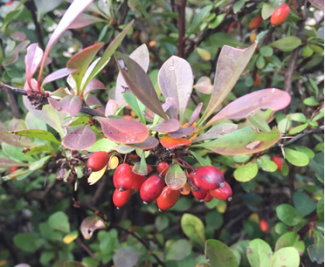
Japanese Barberry (Berberis thunbergii)
• Spiny, deciduous shrub with cultivars that are available with green, yellow, or purple foliage
• Leafs out early and spreads vegetatively as thickets in the understory of
woods
• Most cultivars produce fruit, which often contain viable seeds
Recommended Alternatives: for yellow and purple foliage
* Fothergilla (Fothergilla spp.)-US
* Lemony LaceTM elderberry (Sambucus racemosa)-CV
* New Jersey tea (Ceanothus americanus)
* Ninebark (Physocarpus opulifolius 'Little Devil' and other CVs)
* Shrubby cinquefoil (Dasiphora fruticosa)
* Spireas: Tor birchleaf spirea (Spiraea betulifolia 'Tor')-CV; Steeplebush (S. tomentosa)
* Winterberry (Ilex verticillata)-CVs
• Spiny, deciduous shrub with cultivars that are available with green, yellow, or purple foliage
• Leafs out early and spreads vegetatively as thickets in the understory of
woods
• Most cultivars produce fruit, which often contain viable seeds
Recommended Alternatives: for yellow and purple foliage
* Fothergilla (Fothergilla spp.)-US
* Lemony LaceTM elderberry (Sambucus racemosa)-CV
* New Jersey tea (Ceanothus americanus)
* Ninebark (Physocarpus opulifolius 'Little Devil' and other CVs)
* Shrubby cinquefoil (Dasiphora fruticosa)
* Spireas: Tor birchleaf spirea (Spiraea betulifolia 'Tor')-CV; Steeplebush (S. tomentosa)
* Winterberry (Ilex verticillata)-CVs
VINES
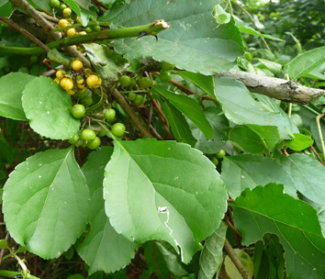
Asian Bittersweet (Celastrus orbiculatus)
• Deciduous, twining woody vine that climbs and covers trees and other
vegetation
• Orange-red fruits have been used in craft arrangements
• Often hybridizes with native American bittersweet
(Be sure to identify oriental bittersweet correctly before removing it, as American bittersweet is similar. Visit the OIPC website at www.oipc.info for more information on identification.)
Recommended Alternatives:
* Native clematis (Clematis virginiana) & CV 'Veronica's Choice'
* Trumpet honeysuckle (Lonicera sempervirens)-US
* Virginia creeper (Parthenocissus quinequefolia)
* Winter Gold winterberry (Ilex verticillata)-CV
* Woolly pipevine (Aristolochia tomentosa)-US
• Deciduous, twining woody vine that climbs and covers trees and other
vegetation
• Orange-red fruits have been used in craft arrangements
• Often hybridizes with native American bittersweet
(Be sure to identify oriental bittersweet correctly before removing it, as American bittersweet is similar. Visit the OIPC website at www.oipc.info for more information on identification.)
Recommended Alternatives:
* Native clematis (Clematis virginiana) & CV 'Veronica's Choice'
* Trumpet honeysuckle (Lonicera sempervirens)-US
* Virginia creeper (Parthenocissus quinequefolia)
* Winter Gold winterberry (Ilex verticillata)-CV
* Woolly pipevine (Aristolochia tomentosa)-US
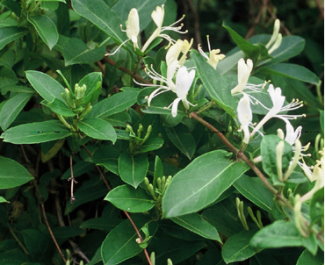
Japanese Honeysuckle (Lonicera japonica)
• Semi-evergreen, sprawling woody vine that climbs over other vegetation, fragrant flowers
• Spreads by trailing branches and produces black berries
• Often blankets the ground in woods
Recommended Alternatives:
* American groundnut (Apios americana)
* Crossvine (Bignonia capreolata)-OH
* Native clematis (Clematis virginiana) & CV 'Veronica's Choice'
* Trumpet honeysuckle (Lonicera sempervirens)-US
* Virginia creeper (Parthenocissus quinequefolia)
* Woodbine honeysuckle (Lonicera periclymenum)-NN
• Semi-evergreen, sprawling woody vine that climbs over other vegetation, fragrant flowers
• Spreads by trailing branches and produces black berries
• Often blankets the ground in woods
Recommended Alternatives:
* American groundnut (Apios americana)
* Crossvine (Bignonia capreolata)-OH
* Native clematis (Clematis virginiana) & CV 'Veronica's Choice'
* Trumpet honeysuckle (Lonicera sempervirens)-US
* Virginia creeper (Parthenocissus quinequefolia)
* Woodbine honeysuckle (Lonicera periclymenum)-NN
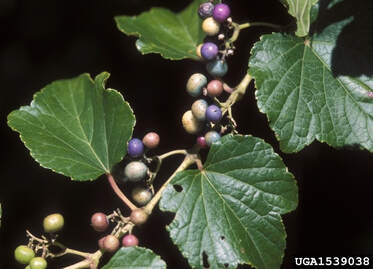
Porcelainberry (Ampelopsis brevipedunculata)*
• Perennial, woody vine that looks similar to grape vines
• Stem pith is white and stem has many lenticels (unlike grapes)
• Alternate leaves are palmately 3-5 lobed, heart-shaped at base
• Flowers are inconspicuous greenish-white, but fruits are colorful, turning from lilac to blue
Recommended Alternatives:
* Heartleaf peppervine (Ampelopsis cordata)
* Trumpet honeysuckle (Lonicera sempervirens)-US
* Virginia creeper (Parthenocissus quinequefolia)
• Perennial, woody vine that looks similar to grape vines
• Stem pith is white and stem has many lenticels (unlike grapes)
• Alternate leaves are palmately 3-5 lobed, heart-shaped at base
• Flowers are inconspicuous greenish-white, but fruits are colorful, turning from lilac to blue
Recommended Alternatives:
* Heartleaf peppervine (Ampelopsis cordata)
* Trumpet honeysuckle (Lonicera sempervirens)-US
* Virginia creeper (Parthenocissus quinequefolia)
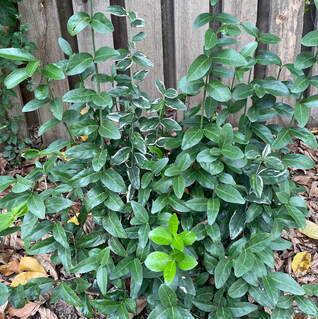
Wintercreeper (Euonymus fortunei)
• Evergreen, woody vine with aerial roots, allowing it to climb into tree
canopies
• Forms carpets on ground in woods, can overtop and shade out trees
• Waxy leaves make it difficult to control, even with herbicide application
Recommended Alternatives:
* Allegheny pachysandra (Pachysandra procumbens)-US
* Canadian wild-ginger (Asarum canadense)-OH
* Flowering spurge (Euphorbia corollate 'Carolina Snow')-CV
* Gro-low fragrant sumac (Rhus aromatica 'Gro-low')-CV
* St. Andrews cross (Hypericum calycinum)
• Evergreen, woody vine with aerial roots, allowing it to climb into tree
canopies
• Forms carpets on ground in woods, can overtop and shade out trees
• Waxy leaves make it difficult to control, even with herbicide application
Recommended Alternatives:
* Allegheny pachysandra (Pachysandra procumbens)-US
* Canadian wild-ginger (Asarum canadense)-OH
* Flowering spurge (Euphorbia corollate 'Carolina Snow')-CV
* Gro-low fragrant sumac (Rhus aromatica 'Gro-low')-CV
* St. Andrews cross (Hypericum calycinum)
FORBS AND GRASSES
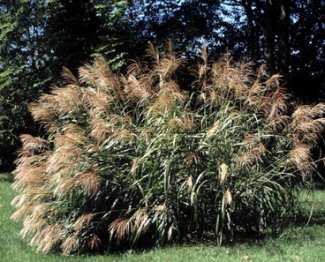
Chinese Silver Grass (Miscanthus sinensis)
• Tall (3-8’), perennial grass with large plume-like flower clusters
• Aggressively spreads into grasslands and open areas
• Many cultivars on the market are fertile, which may produce abundant
seedlings
Recommended Alternatives:
* Big bluestem (Andropogon gerardii)-OH
* Indian grass (Sorghastrum nutans)-OH
* Little bluestem (Schizachyrium scoparium)-many CVs
* Sweet or vanilla grass (Hierochloe odorata)
* Switch grass (Panicum virgatum)-OH
* Wood reed grass (Cinnamon arundinaceae)
• Tall (3-8’), perennial grass with large plume-like flower clusters
• Aggressively spreads into grasslands and open areas
• Many cultivars on the market are fertile, which may produce abundant
seedlings
Recommended Alternatives:
* Big bluestem (Andropogon gerardii)-OH
* Indian grass (Sorghastrum nutans)-OH
* Little bluestem (Schizachyrium scoparium)-many CVs
* Sweet or vanilla grass (Hierochloe odorata)
* Switch grass (Panicum virgatum)-OH
* Wood reed grass (Cinnamon arundinaceae)
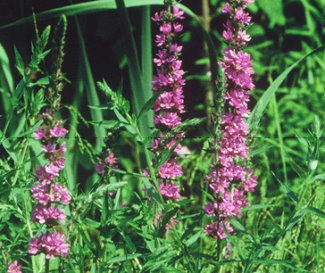
Purple Loosestrife (Lythrum salicaria)
• Herbaceous perennial with enormous seed production
• Forms dense populations in wetlands, displacing nearly all native plants
• Cultivars marked as "sterile" often set seed when in proximity to invasive L. salicaria populations
Recommended Alternatives:
* Anise hyssop (Agastache foeniculum)
* Carolina phlox (Phlox carolina)-US
* Hoary vervain (Verbena stricta)
* Ironweed (Vernonia fasiculataI)
* Ohio spiderwort (Tradescantia ohiensis)
* Spiked blazing-star (Liatris spicata)-OH
* Swamp milkweed (Asclepias incarnata)-OH
• Herbaceous perennial with enormous seed production
• Forms dense populations in wetlands, displacing nearly all native plants
• Cultivars marked as "sterile" often set seed when in proximity to invasive L. salicaria populations
Recommended Alternatives:
* Anise hyssop (Agastache foeniculum)
* Carolina phlox (Phlox carolina)-US
* Hoary vervain (Verbena stricta)
* Ironweed (Vernonia fasiculataI)
* Ohio spiderwort (Tradescantia ohiensis)
* Spiked blazing-star (Liatris spicata)-OH
* Swamp milkweed (Asclepias incarnata)-OH
